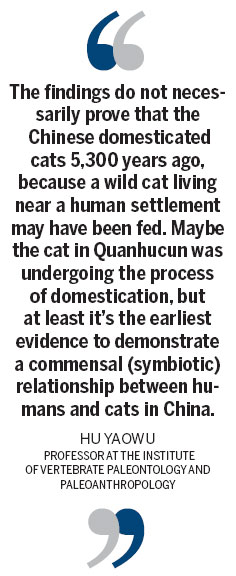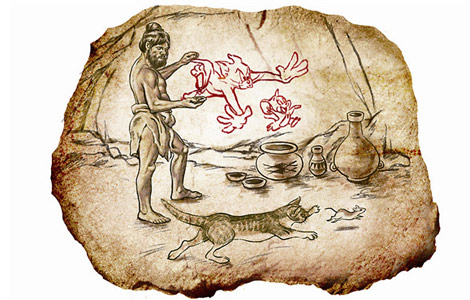Find provides grave paws for thought
Updated: 2014-01-31 06:44
By Zhang Lei (China Daily Europe)
|
|||||||||||
The discovery of ancient bones in a village in Shaanxi province may challenge widely accepted theories about the earliest relationships between felines and humans, zhang lei reports
For many cat lovers, the best thing about felines is their unpredictability; sometimes they act as though they worship their "owners", but often they behave as though they have been carved from an iceberg, implacable and devoid of compassion. That unpredictability raises the question of why humans tolerated such capricious behavior in the first place.
Archeological evidence strongly suggests that the ancient Egyptians worshipped cats at least 4,000 years ago, elevating them to the status of gods and keeping them as life companions. Paintings in pyramids seem to support a general belief that the ancient Egyptians were the first humans to domesticate cats, setting an example to the rest of the world, which gradually caught up.
However, that view is now being challenged after the discovery of cat bones dating back 5,300 years in the village of Quanhucun in Shaanxi province.
The discovery was unexpected, according to Hu Yaowu, a professor at the Institute of Vertebrate Paleontology and Paleoanthropology in Beijing. "The cat bones were unearthed in 2007, along with other animal bones, and locked up in the inventory room. It was not until last year that we started researching the history of ancient farming and accidentally came across eight pieces of cat bone from three different ash pits," he says.
The bones of all animals have a fixed amount of a radioactive isotope called carbon-14, which decays at a specific, stable rate after death, thus allowing scientists to determine their approximate age.

In addition to carbon-14 dating, Hu's team also tested the bones to identify the animals' food consumption structure by analyzing the amount of carbon-13 and nitrogen-5 present. A high level of carbon-13 suggests a large intake of grain-based foods, while high levels of nitrogen-5 equate to meat-based foods.
Cats are fundamentally predators, almost solely dependent on the ingestion of proteins. One of the eight specimens of cat bone was older than the others and the high levels of carbon-13 found in the specimen suggested that cat must have eaten very little meat but a substantial amount of grain-based food, leading scientists to believe it ate leftovers or was fed regularly by humans.
A symbiotic relationship
"The findings do not necessarily prove that the Chinese domesticated cats 5,300 years ago, because a wild cat living near a human settlement may have been fed. Maybe the cat in Quanhucun was undergoing the process of domestication, but at least it's the earliest evidence to demonstrate a commensal (symbiotic) relationship between humans and cats in China," Hu says.
Cats are among the most-loved domestic pets nowadays, second only to dogs, but little is known about how they became domesticated. Before the discovery, scientists worked on the theory of a "commensal pathway to domestication", a method entirely different from that used for dogs, where our human ancestors deliberately domesticated certain species of wolves, which adopted many of the characteristics present in dogs, for their hunting needs 10,000 years ago.
"Our theory is that rodents invaded agricultural villages in search of grain-based foods, suggesting the humans had cultivated a certain level of agricultural civilization. Cats also came to the area to prey on the rodents. While the farmers hated the rodents, they welcomed the coming of the predators, and provided food as encouragement. These findings provide evidence for a commensal process of cat domestication," Hu says.
The skeletons of Asiatic cat species, such as the Central Asian wildcat and the Chinese desert cat, are rarely seen in collections, and there are few details of the sizes and measurements of ancient cats. Therefore, Hu Yaowu and Hu Songmei, a professor at the Shaanxi Provincial Institute of Archeology, compared the size of the animals in Quanhucun with published data about modern European wildcats. The Quanhucun cats were larger than domesticated European cats, but smaller than, and outside the range of, European wildcats.
"The key to establishing if the cats were domestic or wild is whether they were fed regularly by humans. We have to obtain additional information on the range of size variation in Asian wildcats and DNA evidence to secure identification," Hu says.
According to Li Jianmin, a professor at the College of Wildlife Resources, Northeast Forestry University, cats are not ideal candidates for domestication, but mutual interests resulted in felines and humans bonding together.
"Most of the animals that became domesticated were gregarious groups with significant class distinctions. Our ancestors took advantage of those distinctions, replacing the 'leaders' and thus establishing more cohesive and effective control over the animals. As long as there was sufficient food, animals such as pigs, cows and sheep adapted easily to small, enclosed spaces," he says.

"Instead, the cat is a solitary hunter. To defend their own territory, they act ruthlessly toward their peers. In addition, most domesticated animals mainly eat plants; even dogs evolved from predators to omnivores and can eat practically anything. Cats, however, are 'obligate carnivores', which means they can't digest anything other than meat," he adds.
Cats cannot digest carbohydrates and are unable to taste sweet food. Moreover, even domesticated cats are often disobedient. These characteristics suggest that the ancestors of modern domestic cats were willing to live with people simply because they saw opportunities in human communities.
Hu Yaowu refers to this pattern of behavior as "self-domestication". Rather than humans taking the lead, some scientists contend that cats "domesticated humans", who were deceived into believing the opposite.
Hu says the findings in Quanhucun may challenge the established belief that the earliest communication between East and West occurred via the Silk Road 2,000 years ago. The Yangshao Culture (7000-5000 BC) was the first Neolithic Chinese culture within the territory of the Yellow River valley, and the Quanhucun site belongs to the Middle to Late Yangshao Culture (6000-5000 BC).
The Fertile Crescent
If the cats in the region weren't domesticated by the Chinese, it's highly possible that they were introduced from the Fertile Crescent - a relatively moist and fertile zone in Western Asia, the Nile valley and its delta. Studies of the DNA of both modern feral and domestic cats demonstrate that the ancient wildcats of the Fertile Crescent were their maternal ancestors. The semi-arid region also gave birth to the earliest human agricultural civilizations; the cultivation of beans and wheat is known to have originated there, along with the first domesticated sheep, pigs and cows.
"Modern Chinese domestic cats may have originated from the Fertile Crescent. If that's the case, we can say that the Chinese started to communicate with the West much earlier than previously thought, so the connection may well go back 5,000 years. This will help us to study the spread of agriculture across the globe," Hu says.
Rats are a great temptation to cats, which made the garbage dumps in ancient villages tremendously appealing. Unlike their cousins, lions, leopards and suchlike, cats living in the ancient settlements didn't need to sharpen their hunting skills.
When the sources of food were relatively stable, the cats adapted to a companionable life alongside humans. Yet they are a solitary species and fierce competition for resources and survival not only challenged their evolution, but also limited their degree of obedience to humans.
Over time, they began to better integrate with the human environment, while remaining adept hunters with the ability to distinguish food from garbage. Even today, most domestic cats can survive easily, even if they are abandoned. "That point is proved by the large numbers of stray cats in the cities. You don't see large numbers of stray dogs, because they are unlikely to survive for long," Hu says.
Cute and clever
During the process of assimilation, cats may have altered some of their features to develop a more intimate relationship with humans. Compared with their feral counterparts, domestic cats have bigger eyes, flatter, rounder faces and higher foreheads, thus presenting a cute and clever appearance that encourages people to feed them.
In 2004, Jean-Denis Vigne, an archeologist with the National Museum of Natural History in Paris, discovered the bones of a wild cat alongside human remains in a 9,500-year-old grave on the island of Cyprus, currently the earliest discovery of a connection between humans and cats.
It may be that feline evolution will begin all over again as cats adapt to changes in human behavior brought about by technology - modern dogs have a completely different appearance to their ancestors, while in general domestic cats still maintain many links with their feral forebears.
Perhaps during the long hours they spend asleep - the main priority for some, or so it seems - cats engage in philosophical contemplation, meditating on the mysteries of the universe and the meaning of life alongside humans.
After all, as Detlef Bluhm, one of Germany's greatest feline experts, wrote in The Big Cat Encyclopaedia, "cats are witnesses of the progress of human civilization".
Contact the writer at zhanglei@chinadaily.com.cn

|
Field specimens from Quanhucun showing key body parts and the presence of an aged animal with worn teeth. The pieces are: A. left mandible with worn fourth premolar and first molar; B. right humerus; C. left pelvis; and D. proximal left tibia. Provided to China Daily |
(China Daily European Weekly 01/31/2014 page24)
Today's Top News
Trade frictions with the EU likely to grow
Xi, Putin vow stronger ties
Pollution dampens fireworks sale
US warns airlines about 'toothpaste bombs'
Dutch security services bug phones
President Xi leaves for Sochi ceremony
Vatican's child abuse record slammed
Schroeder accuses US of disrespect
Hot Topics
Lunar probe , China growth forecasts, Emission rules get tougher, China seen through 'colored lens', International board,
Editor's Picks

|

|

|

|

|

|






